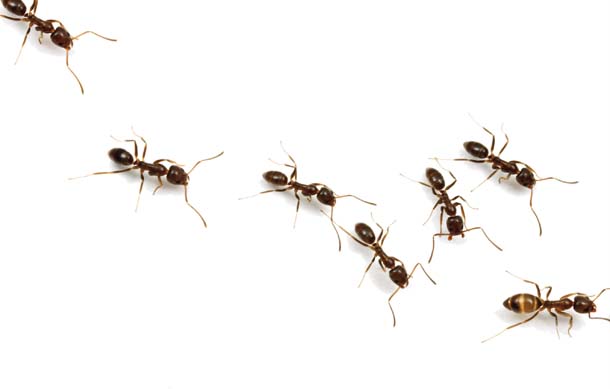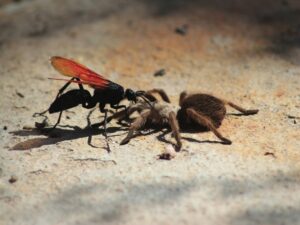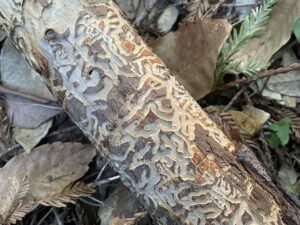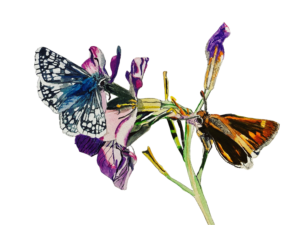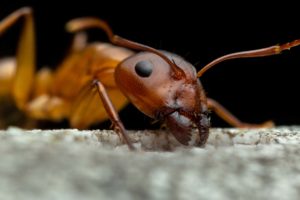Looking for info on joining the Bay Area Ant Survey? Jump to it.
It’s a perfect day for a picnic. The kids are off playing, you’re spreading the food out, the sun is warm and toasty. You just lie there for a minute enjoying the moment. What’s this? A couple of ants crawling on your arm–no big deal. But then there are more: You sit up and find hordes of ants covering your cookies, climbing into your soda–they’re everywhere!
Ants might be small, but they are many. Scientists say that if you collected all the billions of ants in the world and weighed them (that’s their “biomass”), they’d be heavier than all the people on earth put together. That’s a lot of ants–about a thousand trillion!
Luckily they won’t all show up at your picnic. But a single ant colony can contain many thousands of individuals, and since ants communicate with each other about food they find, a visit from a couple of ants often turns into a deluge of hundreds.
- Argentine ants on the march. Most ants you’ll see in the Bay Area are Argentines, though they aren’t native here. Photo by Alex Wild, alexanderwild.com.
Ants, like bees, termites, and some wasps, are social insects. They live in large groups and have strict divisions of labor. Workers bring food such as seeds, dead insects, leaves, or fruit back into the colony. Other ants stay in the nest, storing food in special rooms or tending to the queen and her eggs. Nearly all the ants in a colony are female. Males are kept around only to mate with the queen. Once their job is finished, they are either forced out of the nest or killed and discarded.
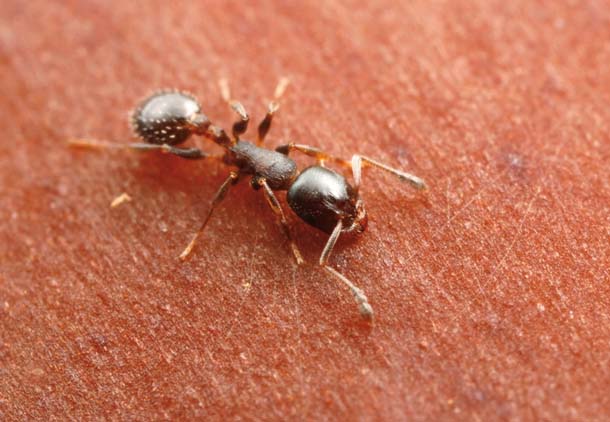
- This small native ant nests in manzanita shrubs and is seen here on manzanita bark. Photo by Alex Wild, alexanderwild.com.
To keep their colony running like a well-oiled machine, ants communicate with each other using chemical scents and physical contact. The chemicals, or pheromones, ants use to communicate can signal where to find food, alert others to the presence of an enemy, or identify nestmates. Watch ants walking along and see them tap their abdomens to the ground. They are leaving tiny droplets of chemical instructions for their sisters.
The Bay Area is home to many different ant species, but nonnative Argentine ants are the most common. They live in huge colonies, and they overpower and destroy native ant nests wherever they find them.
Naturalists at the California Academy of Sciences have been doing a Bay Area Ant Survey for several years, with help from the public. The academy has a huge collection of ants already, but this study has helped scientists confirm the distribution of 34 species of native ants so far and also show the spread of nonnatives like the Argentines.
You can find ants easily in almost every local habitat. Many nest under logs or rocks. Some can be found gathering nectar from flowers. Harvester ants collect seeds, so search for them in sunny clearings near grasslands. Large black carpenter ants make their homes inside wood like rotting logs and dead trees–and sometimes even in the walls of your house. Though you might have heard scary stories of fire ants–aggressive biting ants from Brazil that reached Southern California in the 1990s–they haven’t appeared in the Bay Area, yet.
Since ants are pretty small, you’ll need a magnifying glass to get a really good look at them. It helps to put them in a small, clear container. You’ll be surprised by their miniature beauty.
Ants are most active outdoors during the warmer months, so now is the time to keep an eye out for them. But don’t worry if you have trouble tracking them down. Next time you have a picnic, they’ll find you!
Get Out!
by Sue Rosenthal

- Like all ants, these native carpenter ants communicate through touch and chemical signals. Photo by Alex Wild, alexanderwild.com.
You can look inside working ant colonies at three Bay Area museums. At the SF Zoo’s Insect Zoo, red harvester ants from the Southwest live in a large arena where visitors can watch as the eggs, larvae, and pupae are cared for by “attend-ants” [sfzoo.org, (415)753-7080 x7053]. At the Oakland Zoo, honeypot ants and leafcutter ants (also from parts south) live in glassed-in colonies, so you can watch them foraging and tending their young [oaklandzoo.org, (510)632-9525, x100]. And there’s a very active colony of leafcutter ants living in the California Academy of Sciences’ four-story rainforest exhibit [calacademy.org, (415) 379-8000].
Participate in the Bay Area Ant Survey
Want to find out what kinds of ants live in your neighborhood? You canget expert help identifying them while you gather scientificinformation about Bay Area ant diversity by participating in the BayArea Ant Survey through the California Academy of Sciences (CAS). More than 950 citizen scientists have participated in the Bay Area Ant Survey and so far have found 34 different species of ants. Teachers: Borrow an “Ants in Your School Yard Classroom Kit” for your classroom (see below).
To get started, learn about the Bay Area Ant Survey on the California Academy of Sciences Citizen Science pages and the Bay Area pages of AntWeb.
On the Academy’s website, you’ll find a number of resources:
Argentine Ant–information about the life of this serious pest in California that threatens native ants and other animals.
Ant Fact Box–a box teachers (or anyone) can make for classroom use with printable ant fact strips and printable cut-outs of ants that turn a shoebox into a source of fascinating facts about ants.
Ant Anatomy–descriptions of the parts of an ant with a printable diagram to color.
Identification Key–a downloadable PowerPoint guide to indentifying ant species using a relatively simple key that presents a series of choices and guides the user to the name of the ant.
Data Sheet (for the Bay Area Ant Survey)–a downloadable form to print, fill in, and send in with your ant specimens.
Here’s how you can participate in the Bay Area Ant Survey (if you have questions, call (415) 379-5494, or email naturalist@calacademy.org):
1. Assemble your supplies
Pick up a free collecting kit (a screw-top vial of ethanol and a data sheet) from the Naturalist Center inside the California Academy of Sciences.
If you can’t go to the Academy to pick up the kit, you can make one yourself. Fill a small, leakproof (screw top), unbreakable (plastic or metal) vial with rubbing alcohol (isopropyl alcohol). Print out the data sheet from the Bay Area Ant Survey Citizen Science website.
2. Collect ants
Look for ants anywhere you can think of–in your backyard, in your school yard, in a park. Note that you will need a separate vial for each location where you collect. However, you can use one vial for all thedifferent kinds of ants from one location.
If you can’t find any ants, try setting out bait. Ants love cookies, or honey, or even small pieces of meat.
After an hour or so, check to see if any ants have found your bait. Use a piece of paper or a leaf to pick up the ants; don’t use your fingers, tweezers, or other tools–ants are fragile and easily crushed. Gently drop at least five ants into a vial full of alcohol.
The alcohol preserves the ants’ bodies so they can be added to the Academy’s growing collection. These ants will help scientists track the diversity of ant species in our area as well as their distribution patterns. However, rubbing alcohol will not preserve the ants’ tissues well enough for DNA analysis, which helps the scientists understand more about the ants. The only way to preserve your ants for DNA analysis is with ethanol, so pick up vials from the Academy if you want your ants to provide that kind of information.
3. Record your information on the data sheet
Print a data sheet from the Bay Area Ant Survey website.
Fill in all of the non-optional information on the form: the code on your vial (make one up if you use your own vial), the number of ants collected, the date, your contact information, and information about the location where you collected the ants. Use a separate data sheet and vial for ants from different locations (e.g., from your yard, from your school, from a park).
4. Submit your ants and data sheet
You can either drop off your data sheet and ant-filled vial at the California Academy of Sciences Naturalist Center or package and mail your ants to the Academy.
If you mail your ants, package the vial securely in a padded envelope. Mail the envelope to:
ATTN: Bay Area Ant Survey
Naturalist Center
California Academy of Sciences
55 Music Concourse Drive
San Francisco, CA 94118
5. Optional–Identify your ants yourself (with help)
If you would like to try to identify the ants you collected, make an appointment with the California Academy of Sciences Naturalist Center. The staff will help you work through the Identification Key as you observe your ants’ characteristics through a microscope. Call (415) 379-5494 or email naturalist@calacademy.org to set up an appointment.
6. Find out which species of ants you submitted
Each month, the Academy’s scientists will identify, record, and provide housing for the new ant specimens. You can look up information about your ants on AntWeb (http://www.antweb.org/). If you provide your email address on your data sheet, the Academy will send you an email message with a link to information about the ants you submitted.
For Teachers
A more advanced version of the collecting kit is available especially for educators. The “Ants in Your School Yard Classroom Kit” includes all of the resources you need to participate in the Bay Area Ant Survey as a class: a dissecting microscope, forceps, petri dishes, ethanol-filled vials, pooters, a hand lens, a dichotomous key to the ants of the Bay Area, and data sheets. The activities students can do with the kit are suitable for grades 2-12.
To borrow the classroom kit, a teacher must attend, or must have attended in the past, the “Ants in Your School Yard” workshop at the California Academy of Sciences. The next workshop will be offered on Tuesday, September 21, 2010, 4-6 pm ($30). Sign up for the workshop and browse through the complete list of workshop offerings for the next school year by visiting the academy’s Teacher Workshops web page.
Kit Lending Fee: $30
Loan period: 3 weeks
Kit Reservations: Advance reservation required. To reserve a kit, call (415) 379-5816 or email ssoule@calacademy.org.

.jpg)
